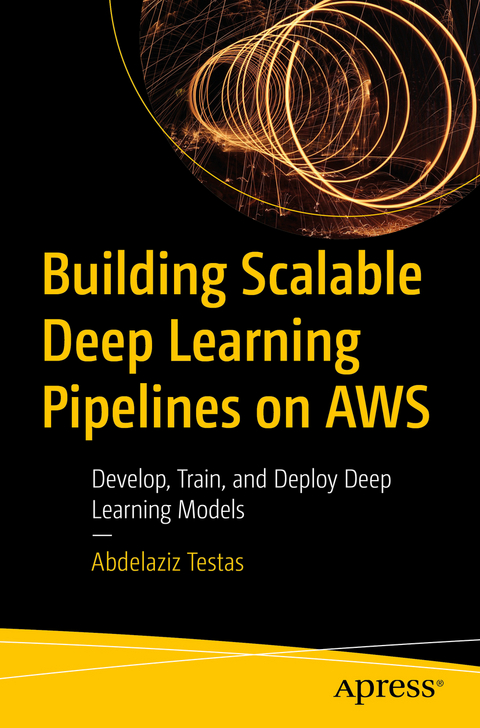
Building Scalable Deep Learning Pipelines on AWS
Apress (Verlag)
979-8-8688-1016-9 (ISBN)
- Noch nicht erschienen - erscheint am 10.01.2025
- Versandkostenfrei innerhalb Deutschlands
- Auch auf Rechnung
- Verfügbarkeit in der Filiale vor Ort prüfen
- Artikel merken
Starting with the importance of scaling advanced machine learning models, this book leverages AWS's robust infrastructure and comprehensive suite of services. It guides you through the setup and configuration needed to maximize the potential of deep learning technologies. You will gain in-depth knowledge of building deep learning pipelines, including data preprocessing, feature engineering, model training, evaluation, and deployment.
The book provides insights into setting up an AWS environment, configuring necessary tools, and using PySpark for distributed data processing. You will also delve into hands-on tutorials for PyTorch and TensorFlow, mastering their roles in building and training neural networks. Additionally, you will learn how Apache Airflow can orchestrate complex workflows and how Amazon S3 and EC2 enhance model deployment at scale.
By the end of this book, you will be equipped to tackle real-world challenges and seize opportunities in the rapidly evolving field of deep learning with AWS. You will gain the insights and skills needed to drive innovation and maintain a competitive edge in today’s data-driven landscape.
What You Will Learn
Maximize AWS services for scalable and high-performance deep learning architectures
Harness the capacity of PyTorch and TensorFlow for advanced neural network development
Utilize PySpark for efficient distributed data processing on AWS
Orchestrate complex workflows with Apache Airflow for seamless data processing, model training, and deployment
Who This Book Is For
Data scientists looking to expand their skill set to include deep learning on AWS, machine learning engineers tasked with designing and deploying machine learning systems who want to incorporate deep learning capabilities into their applications, AI practitioners working across various industries who seek to leverage deep learning for solving complex problems and gaining a competitive advantage
Abdelaziz Testas, PhD, is a seasoned data scientist with over a decade of experience in data analysis and machine learning. He earned his PhD in Economics from the University of Leeds in England and holds a master’s degree in the same field from the University of Glasgow in Scotland. Additionally, he has earned several certifications in computer science and data science in the United States. For over 10 years, Abdelaziz served as a Lead Data Scientist at Nielsen, where he played a pivotal role in enhancing the company’s audience measurement capabilities. He was instrumental in planning, initiating, and executing end-to-end data science projects and developing methodologies that advanced Nielsen’s digital ad and content rating products. His expertise in media measurement and data science drove the creation of innovative solutions. Recently, Abdelaziz transitioned to the public sector, joining the State of California's Department of Health Care Access and Information (HCAI). In his new role, he leverages his coding and data science leadership skills to make a meaningful impact, supporting HCAI’s mission to ensure quality, equitable, and affordable health care for all Californians. Abdelaziz is also the author of Distributed Machine Learning with PySpark: Migrating Effortlessly from Pandas and Scikit-Learn (Apress).
Chapter 1: Overview of Scalable Deep Learning Pipelines on AWS.- Chapter 2: Setting Up a Deep Learning Environment on AWS.- Chapter 3: Data Preparation with PySpark for Deep Learning.- Chapter 4: Deep Learning with PyTorch for Regression.- Chapter 5: Deep Learning with TensorFlow for Regression.- Chapter 6: Deep Learning with PyTorch for Classification.- Chapter 7: Deep Learning with TensorFlow for Classification.- Chapter 8: Scalable Deep Learning Pipelines with Apache Airflow.- Chapter 9: Techniques for Improving Model Performance.- Chapter 10: Deploying and Monitoring Deep Learning Models.
| Erscheinungsdatum | 24.12.2024 |
|---|---|
| Zusatzinfo | 23 Illustrations, color; 2 Illustrations, black and white; Approx. 415 p. |
| Verlagsort | Berlin |
| Sprache | englisch |
| Maße | 155 x 235 mm |
| Themenwelt | Mathematik / Informatik ► Informatik ► Programmiersprachen / -werkzeuge |
| Informatik ► Theorie / Studium ► Künstliche Intelligenz / Robotik | |
| ISBN-13 | 979-8-8688-1016-9 / 9798868810169 |
| Zustand | Neuware |
| Informationen gemäß Produktsicherheitsverordnung (GPSR) | |
| Haben Sie eine Frage zum Produkt? |
aus dem Bereich


